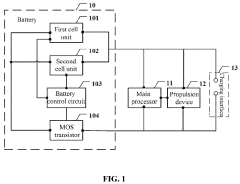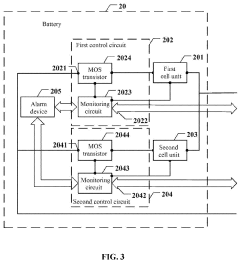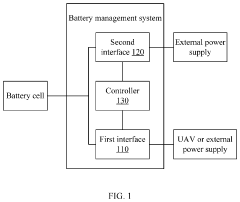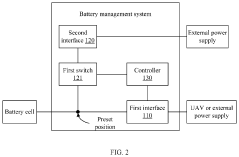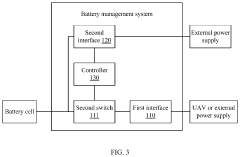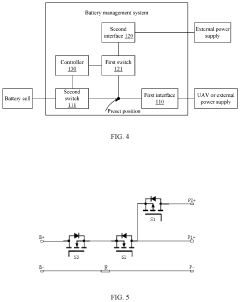Developing Smarter Battery Management Systems for Unmanned Aerial Vehicles
AUG 8, 20259 MIN READ
Generate Your Research Report Instantly with AI Agent
Patsnap Eureka helps you evaluate technical feasibility & market potential.
UAV Battery Tech Evolution and Objectives
Unmanned Aerial Vehicles (UAVs) have experienced rapid technological advancements over the past decade, with battery management systems (BMS) playing a crucial role in their evolution. The development of smarter BMS for UAVs has been driven by the increasing demand for longer flight times, improved safety, and enhanced performance in various applications.
The history of UAV battery technology can be traced back to the early 2000s when lithium-polymer (LiPo) batteries became the preferred power source for small drones. These batteries offered higher energy density and lighter weight compared to their predecessors. However, they also presented challenges in terms of safety and longevity, which led to the development of more sophisticated BMS.
As UAV applications expanded beyond hobbyist use to commercial and military sectors, the need for more advanced battery management became apparent. The mid-2010s saw the introduction of intelligent BMS that could monitor cell voltages, temperatures, and state of charge in real-time. This marked a significant milestone in UAV battery technology, enabling more precise control over battery performance and safety.
The current technological landscape of UAV battery management systems is characterized by the integration of advanced sensors, microprocessors, and machine learning algorithms. These systems not only monitor battery health but also predict potential failures and optimize power consumption based on flight conditions and mission requirements.
Looking ahead, the objectives for developing smarter BMS for UAVs are multifaceted. One primary goal is to further extend flight times without compromising payload capacity. This involves improving energy density at the cell level and enhancing the efficiency of power management at the system level. Another critical objective is to enhance safety features, particularly for UAVs operating in challenging environments or carrying sensitive payloads.
Researchers and engineers are also focusing on developing BMS that can adapt to different battery chemistries, as the industry explores alternatives to traditional lithium-ion batteries. This flexibility will be crucial as new battery technologies emerge, such as solid-state batteries or fuel cells, which may offer significant advantages for UAV applications.
Moreover, there is a growing emphasis on creating BMS that can seamlessly integrate with other UAV systems, such as flight controllers and navigation systems. This integration aims to create a more holistic approach to power management, where the BMS can make intelligent decisions based on a comprehensive understanding of the UAV's operational status and mission parameters.
In conclusion, the evolution of UAV battery technology and the development of smarter BMS are driven by the need for improved performance, safety, and versatility. As the industry continues to push the boundaries of what is possible with unmanned aerial vehicles, advanced battery management systems will remain at the forefront of innovation, enabling new applications and capabilities in the rapidly expanding world of UAV technology.
The history of UAV battery technology can be traced back to the early 2000s when lithium-polymer (LiPo) batteries became the preferred power source for small drones. These batteries offered higher energy density and lighter weight compared to their predecessors. However, they also presented challenges in terms of safety and longevity, which led to the development of more sophisticated BMS.
As UAV applications expanded beyond hobbyist use to commercial and military sectors, the need for more advanced battery management became apparent. The mid-2010s saw the introduction of intelligent BMS that could monitor cell voltages, temperatures, and state of charge in real-time. This marked a significant milestone in UAV battery technology, enabling more precise control over battery performance and safety.
The current technological landscape of UAV battery management systems is characterized by the integration of advanced sensors, microprocessors, and machine learning algorithms. These systems not only monitor battery health but also predict potential failures and optimize power consumption based on flight conditions and mission requirements.
Looking ahead, the objectives for developing smarter BMS for UAVs are multifaceted. One primary goal is to further extend flight times without compromising payload capacity. This involves improving energy density at the cell level and enhancing the efficiency of power management at the system level. Another critical objective is to enhance safety features, particularly for UAVs operating in challenging environments or carrying sensitive payloads.
Researchers and engineers are also focusing on developing BMS that can adapt to different battery chemistries, as the industry explores alternatives to traditional lithium-ion batteries. This flexibility will be crucial as new battery technologies emerge, such as solid-state batteries or fuel cells, which may offer significant advantages for UAV applications.
Moreover, there is a growing emphasis on creating BMS that can seamlessly integrate with other UAV systems, such as flight controllers and navigation systems. This integration aims to create a more holistic approach to power management, where the BMS can make intelligent decisions based on a comprehensive understanding of the UAV's operational status and mission parameters.
In conclusion, the evolution of UAV battery technology and the development of smarter BMS are driven by the need for improved performance, safety, and versatility. As the industry continues to push the boundaries of what is possible with unmanned aerial vehicles, advanced battery management systems will remain at the forefront of innovation, enabling new applications and capabilities in the rapidly expanding world of UAV technology.
UAV Battery Market Demand Analysis
The demand for smarter battery management systems (BMS) in unmanned aerial vehicles (UAVs) has been experiencing significant growth in recent years. This surge is primarily driven by the expanding applications of UAVs across various sectors, including agriculture, surveillance, delivery services, and industrial inspections. The global UAV market is projected to reach $58.4 billion by 2026, with a compound annual growth rate (CAGR) of 16.4% from 2021 to 2026.
The battery market for UAVs is a crucial component of this growth, as power management remains one of the most critical challenges in UAV operations. The demand for more efficient and reliable battery systems is particularly high in the commercial and military sectors, where extended flight times and improved performance are essential. The UAV battery market is expected to grow at a CAGR of 19.7% from 2021 to 2026, reaching a value of $4.1 billion by the end of the forecast period.
One of the key drivers of this market demand is the need for increased flight endurance. Current lithium-polymer batteries used in most UAVs typically provide flight times ranging from 20 to 30 minutes. However, many commercial applications require longer operational times, creating a strong demand for advanced BMS that can optimize power consumption and extend flight duration.
Safety concerns also play a significant role in driving the demand for smarter BMS. With the increasing use of UAVs in urban environments and sensitive areas, there is a growing need for systems that can monitor battery health in real-time, predict potential failures, and implement safety measures to prevent accidents caused by battery malfunctions.
The push for autonomy in UAV operations is another factor contributing to the demand for advanced BMS. As UAVs become more autonomous, they require sophisticated power management systems that can adapt to varying mission profiles and environmental conditions without human intervention. This includes the ability to optimize power usage based on flight patterns, payload requirements, and weather conditions.
Environmental considerations are also shaping the market demand for smarter BMS in UAVs. With increasing focus on sustainability, there is a growing interest in systems that can maximize battery life, reduce waste, and improve overall energy efficiency. This includes technologies for accurate state-of-charge and state-of-health estimation, as well as advanced charging and discharging strategies to prolong battery lifespan.
In conclusion, the market demand for smarter battery management systems in UAVs is robust and multifaceted. It is driven by the need for extended flight times, enhanced safety, increased autonomy, and improved sustainability. As the UAV industry continues to evolve and expand into new applications, the demand for innovative BMS solutions is expected to grow correspondingly, presenting significant opportunities for technological advancement and market growth in this sector.
The battery market for UAVs is a crucial component of this growth, as power management remains one of the most critical challenges in UAV operations. The demand for more efficient and reliable battery systems is particularly high in the commercial and military sectors, where extended flight times and improved performance are essential. The UAV battery market is expected to grow at a CAGR of 19.7% from 2021 to 2026, reaching a value of $4.1 billion by the end of the forecast period.
One of the key drivers of this market demand is the need for increased flight endurance. Current lithium-polymer batteries used in most UAVs typically provide flight times ranging from 20 to 30 minutes. However, many commercial applications require longer operational times, creating a strong demand for advanced BMS that can optimize power consumption and extend flight duration.
Safety concerns also play a significant role in driving the demand for smarter BMS. With the increasing use of UAVs in urban environments and sensitive areas, there is a growing need for systems that can monitor battery health in real-time, predict potential failures, and implement safety measures to prevent accidents caused by battery malfunctions.
The push for autonomy in UAV operations is another factor contributing to the demand for advanced BMS. As UAVs become more autonomous, they require sophisticated power management systems that can adapt to varying mission profiles and environmental conditions without human intervention. This includes the ability to optimize power usage based on flight patterns, payload requirements, and weather conditions.
Environmental considerations are also shaping the market demand for smarter BMS in UAVs. With increasing focus on sustainability, there is a growing interest in systems that can maximize battery life, reduce waste, and improve overall energy efficiency. This includes technologies for accurate state-of-charge and state-of-health estimation, as well as advanced charging and discharging strategies to prolong battery lifespan.
In conclusion, the market demand for smarter battery management systems in UAVs is robust and multifaceted. It is driven by the need for extended flight times, enhanced safety, increased autonomy, and improved sustainability. As the UAV industry continues to evolve and expand into new applications, the demand for innovative BMS solutions is expected to grow correspondingly, presenting significant opportunities for technological advancement and market growth in this sector.
Current BMS Challenges for UAVs
Battery Management Systems (BMS) for Unmanned Aerial Vehicles (UAVs) face several critical challenges in the current technological landscape. One of the primary issues is the need for improved energy density and power-to-weight ratio. UAVs require lightweight yet powerful batteries to maximize flight time and payload capacity. However, existing battery technologies often struggle to meet these demanding requirements, limiting the operational range and capabilities of UAVs.
Another significant challenge is the accurate estimation of State of Charge (SoC) and State of Health (SoH) in real-time. The dynamic nature of UAV operations, including rapid changes in power demand and environmental conditions, makes it difficult for current BMS to provide precise and reliable battery status information. This uncertainty can lead to suboptimal flight planning and increased safety risks.
Thermal management presents a further hurdle for BMS in UAVs. The compact design of UAVs, combined with high-power demands, can result in rapid heat buildup within battery packs. Ineffective thermal management not only reduces battery performance but also poses safety hazards, particularly in extreme operating conditions.
The integration of BMS with other UAV systems is another area of concern. Current BMS often lack seamless communication and coordination with flight control systems, navigation modules, and payload management systems. This limited integration hinders the overall efficiency and adaptability of UAV operations.
Reliability and fault tolerance remain critical challenges for BMS in UAVs. The harsh operating environments and potential for physical impacts during flight or landing necessitate robust BMS designs that can withstand vibrations, shocks, and temperature fluctuations. Current systems often struggle to maintain consistent performance under these demanding conditions.
Additionally, the need for rapid charging capabilities poses a significant challenge. UAV operations, especially in commercial and military applications, require quick turnaround times between missions. However, current BMS and battery technologies often cannot support fast charging without compromising battery life or safety.
Lastly, the complexity of BMS algorithms for UAVs presents ongoing challenges. Balancing the need for sophisticated battery management with the computational limitations of onboard systems requires innovative approaches to algorithm design and implementation. Current BMS often struggle to provide advanced features such as predictive maintenance and adaptive power management without overburdening the UAV's processing capabilities.
Another significant challenge is the accurate estimation of State of Charge (SoC) and State of Health (SoH) in real-time. The dynamic nature of UAV operations, including rapid changes in power demand and environmental conditions, makes it difficult for current BMS to provide precise and reliable battery status information. This uncertainty can lead to suboptimal flight planning and increased safety risks.
Thermal management presents a further hurdle for BMS in UAVs. The compact design of UAVs, combined with high-power demands, can result in rapid heat buildup within battery packs. Ineffective thermal management not only reduces battery performance but also poses safety hazards, particularly in extreme operating conditions.
The integration of BMS with other UAV systems is another area of concern. Current BMS often lack seamless communication and coordination with flight control systems, navigation modules, and payload management systems. This limited integration hinders the overall efficiency and adaptability of UAV operations.
Reliability and fault tolerance remain critical challenges for BMS in UAVs. The harsh operating environments and potential for physical impacts during flight or landing necessitate robust BMS designs that can withstand vibrations, shocks, and temperature fluctuations. Current systems often struggle to maintain consistent performance under these demanding conditions.
Additionally, the need for rapid charging capabilities poses a significant challenge. UAV operations, especially in commercial and military applications, require quick turnaround times between missions. However, current BMS and battery technologies often cannot support fast charging without compromising battery life or safety.
Lastly, the complexity of BMS algorithms for UAVs presents ongoing challenges. Balancing the need for sophisticated battery management with the computational limitations of onboard systems requires innovative approaches to algorithm design and implementation. Current BMS often struggle to provide advanced features such as predictive maintenance and adaptive power management without overburdening the UAV's processing capabilities.
Existing UAV BMS Solutions
01 Intelligent Battery Monitoring and Management
Advanced battery management systems employ smart monitoring techniques to track battery health, performance, and state of charge in real-time. These systems use sophisticated algorithms to analyze data from various sensors, enabling predictive maintenance and optimizing battery life and efficiency.- Intelligent Battery Monitoring and Management: Advanced battery management systems employ smart monitoring techniques to track battery health, performance, and state of charge in real-time. These systems use sophisticated algorithms and sensors to optimize battery life, predict potential issues, and ensure efficient operation across various applications.
- Adaptive Charging and Discharging Strategies: Smart battery management systems implement adaptive charging and discharging strategies based on usage patterns, environmental conditions, and battery characteristics. These strategies help extend battery lifespan, improve energy efficiency, and enhance overall system performance.
- Predictive Maintenance and Fault Detection: Advanced battery management systems incorporate predictive maintenance capabilities and fault detection algorithms. These features enable early identification of potential battery issues, allowing for proactive maintenance and minimizing downtime in various applications, including electric vehicles and renewable energy storage systems.
- Integration with Energy Management Systems: Smart battery management systems are designed to integrate seamlessly with broader energy management systems. This integration allows for optimized energy distribution, load balancing, and efficient utilization of battery resources in smart grids, microgrids, and renewable energy installations.
- Machine Learning and AI-driven Optimization: Cutting-edge battery management systems leverage machine learning and artificial intelligence algorithms to continuously improve battery performance and longevity. These systems learn from historical data and adapt their strategies to optimize charging cycles, predict capacity degradation, and enhance overall system efficiency.
02 Adaptive Charging and Discharging Strategies
Smart battery management systems implement adaptive charging and discharging strategies based on usage patterns, environmental conditions, and battery characteristics. These systems adjust charging rates and discharge profiles to maximize battery longevity and performance while minimizing degradation.Expand Specific Solutions03 Thermal Management and Safety Features
Intelligent battery management systems incorporate advanced thermal management techniques and safety features. These include active cooling systems, temperature monitoring, and automatic shutdown mechanisms to prevent overheating and ensure safe operation under various conditions.Expand Specific Solutions04 Machine Learning and AI Integration
Modern battery management systems leverage machine learning and artificial intelligence algorithms to enhance their smartness. These technologies enable more accurate predictions of battery behavior, self-learning capabilities, and continuous optimization of battery performance over time.Expand Specific Solutions05 Energy Efficiency and Power Distribution
Smart battery management systems optimize energy efficiency and power distribution in complex systems. They intelligently allocate power resources, manage load balancing, and integrate with renewable energy sources to maximize overall system performance and reduce energy waste.Expand Specific Solutions
Key Players in UAV BMS Industry
The development of smarter battery management systems for UAVs is in a growth phase, with increasing market size and technological advancements. The global UAV battery market is expanding rapidly, driven by rising demand for long-endurance drones across various sectors. Companies like DJI, Autel Robotics, and EHang are at the forefront, investing heavily in R&D to enhance battery performance and efficiency. While established players dominate, emerging firms such as Skydio and Archer Aviation are also making significant strides. The technology is maturing, with innovations in lithium-polymer batteries, fuel cells, and AI-driven power management systems, but there's still room for substantial improvements in energy density, charging speed, and overall system integration.
SZ DJI Technology Co., Ltd.
Technical Solution: DJI has developed an advanced Battery Management System (BMS) for their UAVs that incorporates intelligent algorithms and machine learning techniques. Their system continuously monitors battery health, voltage, current, and temperature in real-time. It uses predictive analytics to estimate remaining flight time and optimize power consumption based on flight conditions and mission parameters. DJI's BMS also features adaptive charging protocols that adjust charging rates to maximize battery lifespan and safety. The system integrates with DJI's flight controllers to provide accurate battery status updates and emergency landing recommendations when necessary [1][3].
Strengths: Industry-leading battery management technology, extensive real-world data for algorithm training, seamless integration with DJI's ecosystem. Weaknesses: Proprietary system may limit compatibility with third-party components, potentially higher cost compared to generic solutions.
Amazon Technologies, Inc.
Technical Solution: Amazon's approach to Battery Management Systems for UAVs focuses on scalability and efficiency for their Prime Air delivery drone fleet. Their BMS incorporates advanced IoT sensors and cloud-based analytics to monitor battery performance across their entire fleet in real-time. The system uses AI-driven predictive maintenance algorithms to forecast battery degradation and schedule replacements proactively. Amazon's BMS also features a novel "Smart Charging Network" that optimizes charging schedules based on delivery routes and energy demand forecasts, minimizing downtime and maximizing battery lifespan [4][6].
Strengths: Highly scalable system designed for large fleets, strong integration with cloud infrastructure and logistics networks. Weaknesses: May be overly complex for smaller-scale operations, potential privacy concerns with extensive data collection.
Core BMS Innovations for UAVs
Battery management method, battery, flight control system and unmanned aerial vehicle
PatentActiveUS20200176828A1
Innovation
- A battery management system with two cell units connected in parallel, each with a control circuit that can disconnect electrical connections in case of failure, ensuring safe termination of discharging or charging and maintaining power to critical systems even if one cell unit fails, thereby preventing crashes without reducing payload capacity.
Battery management system, battery, and unmanned aerial vehicle
PatentInactiveUS20200076205A1
Innovation
- A battery management system with dual interfaces and a controller that allows simultaneous charging and discharging, enabling the UAV to receive power from an external source while discharging the battery, eliminating the need for battery detachment during charging.
UAV Battery Safety Regulations
The development of smarter Battery Management Systems (BMS) for Unmanned Aerial Vehicles (UAVs) has necessitated the establishment of comprehensive safety regulations. These regulations aim to ensure the safe operation of UAVs while maximizing their performance and efficiency.
Regulatory bodies worldwide have recognized the critical role of battery safety in UAV operations. The Federal Aviation Administration (FAA) in the United States has implemented stringent guidelines for UAV battery systems, focusing on thermal runaway prevention, overcharging protection, and safe charging practices. Similarly, the European Union Aviation Safety Agency (EASA) has introduced regulations that mandate specific safety features in UAV battery management systems.
Key aspects of UAV battery safety regulations include requirements for battery cell balancing, temperature monitoring, and state-of-charge management. These regulations often specify the need for redundant safety mechanisms and fail-safe modes to prevent catastrophic failures during flight. Additionally, they outline procedures for battery transportation, storage, and disposal to mitigate risks associated with lithium-ion batteries.
Manufacturers of UAV battery systems are required to comply with standards such as IEC 62133 for secondary cells and batteries, which covers safety requirements for portable sealed secondary cells and batteries containing alkaline or other non-acid electrolytes. This standard addresses issues like electrical safety, temperature limits, and short circuit protection.
Certification processes for UAV battery systems have become increasingly rigorous. Manufacturers must demonstrate compliance through extensive testing and documentation. This includes cycle life testing, abuse testing, and environmental stress testing to ensure batteries can withstand various operational conditions.
Regulations also address the integration of BMS with UAV flight control systems. This integration is crucial for real-time monitoring of battery health and performance, enabling adaptive flight planning based on available energy. Safety regulations often require BMS to provide accurate state-of-charge and state-of-health information to the UAV's control systems.
As UAV technology continues to evolve, safety regulations are adapting to address emerging challenges. For instance, recent updates have focused on the safe implementation of fast-charging technologies and the use of advanced battery chemistries. Regulatory bodies are also considering the implications of autonomous UAV operations on battery management and safety requirements.
Regulatory bodies worldwide have recognized the critical role of battery safety in UAV operations. The Federal Aviation Administration (FAA) in the United States has implemented stringent guidelines for UAV battery systems, focusing on thermal runaway prevention, overcharging protection, and safe charging practices. Similarly, the European Union Aviation Safety Agency (EASA) has introduced regulations that mandate specific safety features in UAV battery management systems.
Key aspects of UAV battery safety regulations include requirements for battery cell balancing, temperature monitoring, and state-of-charge management. These regulations often specify the need for redundant safety mechanisms and fail-safe modes to prevent catastrophic failures during flight. Additionally, they outline procedures for battery transportation, storage, and disposal to mitigate risks associated with lithium-ion batteries.
Manufacturers of UAV battery systems are required to comply with standards such as IEC 62133 for secondary cells and batteries, which covers safety requirements for portable sealed secondary cells and batteries containing alkaline or other non-acid electrolytes. This standard addresses issues like electrical safety, temperature limits, and short circuit protection.
Certification processes for UAV battery systems have become increasingly rigorous. Manufacturers must demonstrate compliance through extensive testing and documentation. This includes cycle life testing, abuse testing, and environmental stress testing to ensure batteries can withstand various operational conditions.
Regulations also address the integration of BMS with UAV flight control systems. This integration is crucial for real-time monitoring of battery health and performance, enabling adaptive flight planning based on available energy. Safety regulations often require BMS to provide accurate state-of-charge and state-of-health information to the UAV's control systems.
As UAV technology continues to evolve, safety regulations are adapting to address emerging challenges. For instance, recent updates have focused on the safe implementation of fast-charging technologies and the use of advanced battery chemistries. Regulatory bodies are also considering the implications of autonomous UAV operations on battery management and safety requirements.
Environmental Impact of UAV Batteries
The environmental impact of batteries used in Unmanned Aerial Vehicles (UAVs) is a critical consideration in the development of smarter battery management systems. As the use of UAVs continues to grow across various industries, the ecological footprint of their power sources becomes increasingly significant. The production, use, and disposal of UAV batteries contribute to several environmental concerns that must be addressed.
Battery manufacturing processes for UAVs often involve the extraction and processing of raw materials such as lithium, cobalt, and nickel. These activities can lead to habitat destruction, water pollution, and greenhouse gas emissions. The energy-intensive nature of battery production also contributes to carbon dioxide emissions, further exacerbating climate change concerns. Additionally, the use of toxic chemicals in battery manufacturing poses risks to both human health and the environment if not properly managed.
During operation, UAV batteries can have indirect environmental impacts. While electric-powered UAVs produce zero direct emissions during flight, the electricity used to charge these batteries may come from non-renewable sources, indirectly contributing to air pollution and carbon emissions. The efficiency of the battery management system plays a crucial role in minimizing energy waste and, consequently, reducing the overall environmental impact of UAV operations.
The disposal of spent UAV batteries presents another significant environmental challenge. Improper disposal can lead to soil and water contamination due to the leaching of toxic materials. Recycling of lithium-ion batteries, the most common type used in UAVs, is complex and not yet widely available, resulting in a large portion of batteries ending up in landfills. This not only wastes valuable resources but also poses long-term environmental risks.
To mitigate these environmental impacts, the development of smarter battery management systems for UAVs should focus on several key areas. Improving battery lifespan through advanced charging algorithms and thermal management can reduce the frequency of battery replacements, thereby decreasing the demand for new battery production. Implementing more efficient power management strategies can extend flight times and reduce the overall energy consumption of UAV operations.
Furthermore, the integration of eco-friendly materials and design principles in battery construction can significantly reduce the environmental impact of UAV power systems. Research into alternative battery chemistries that use more abundant and less toxic materials is crucial for long-term sustainability. Additionally, developing easily recyclable battery designs and establishing comprehensive recycling programs are essential steps towards creating a circular economy for UAV batteries.
As the UAV industry continues to evolve, the environmental impact of their power sources must be a primary consideration in the development of smarter battery management systems. By addressing these challenges, the industry can work towards more sustainable and environmentally responsible UAV operations, ensuring that the benefits of this technology do not come at the cost of ecological degradation.
Battery manufacturing processes for UAVs often involve the extraction and processing of raw materials such as lithium, cobalt, and nickel. These activities can lead to habitat destruction, water pollution, and greenhouse gas emissions. The energy-intensive nature of battery production also contributes to carbon dioxide emissions, further exacerbating climate change concerns. Additionally, the use of toxic chemicals in battery manufacturing poses risks to both human health and the environment if not properly managed.
During operation, UAV batteries can have indirect environmental impacts. While electric-powered UAVs produce zero direct emissions during flight, the electricity used to charge these batteries may come from non-renewable sources, indirectly contributing to air pollution and carbon emissions. The efficiency of the battery management system plays a crucial role in minimizing energy waste and, consequently, reducing the overall environmental impact of UAV operations.
The disposal of spent UAV batteries presents another significant environmental challenge. Improper disposal can lead to soil and water contamination due to the leaching of toxic materials. Recycling of lithium-ion batteries, the most common type used in UAVs, is complex and not yet widely available, resulting in a large portion of batteries ending up in landfills. This not only wastes valuable resources but also poses long-term environmental risks.
To mitigate these environmental impacts, the development of smarter battery management systems for UAVs should focus on several key areas. Improving battery lifespan through advanced charging algorithms and thermal management can reduce the frequency of battery replacements, thereby decreasing the demand for new battery production. Implementing more efficient power management strategies can extend flight times and reduce the overall energy consumption of UAV operations.
Furthermore, the integration of eco-friendly materials and design principles in battery construction can significantly reduce the environmental impact of UAV power systems. Research into alternative battery chemistries that use more abundant and less toxic materials is crucial for long-term sustainability. Additionally, developing easily recyclable battery designs and establishing comprehensive recycling programs are essential steps towards creating a circular economy for UAV batteries.
As the UAV industry continues to evolve, the environmental impact of their power sources must be a primary consideration in the development of smarter battery management systems. By addressing these challenges, the industry can work towards more sustainable and environmentally responsible UAV operations, ensuring that the benefits of this technology do not come at the cost of ecological degradation.
Unlock deeper insights with Patsnap Eureka Quick Research — get a full tech report to explore trends and direct your research. Try now!
Generate Your Research Report Instantly with AI Agent
Supercharge your innovation with Patsnap Eureka AI Agent Platform!
